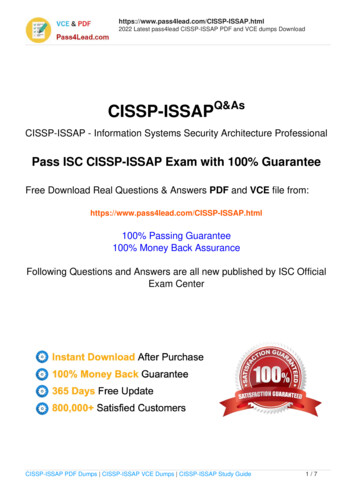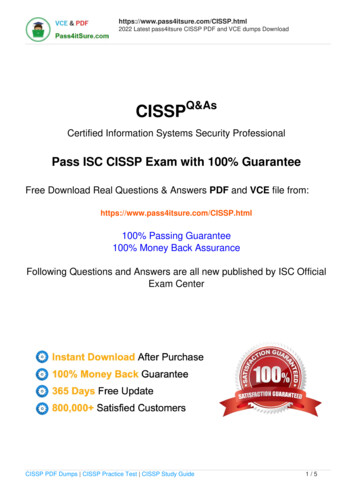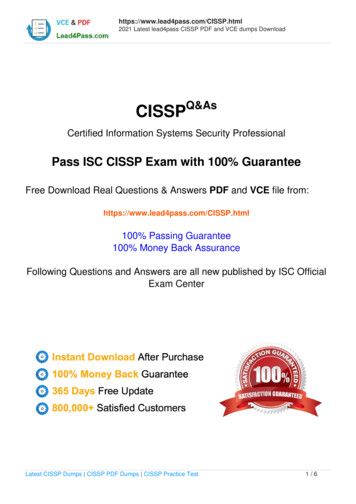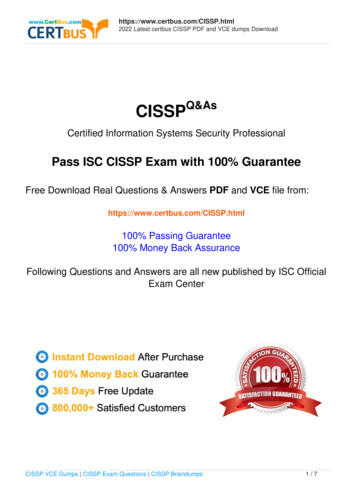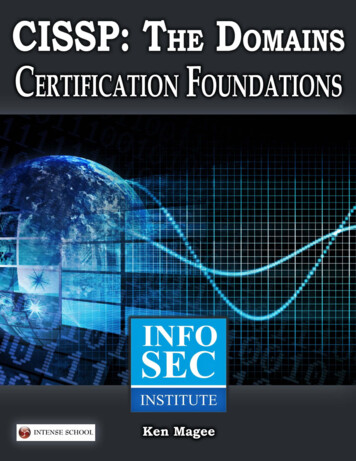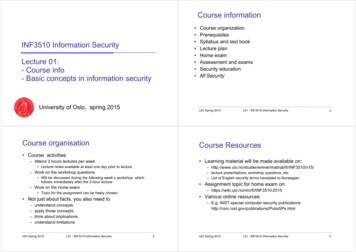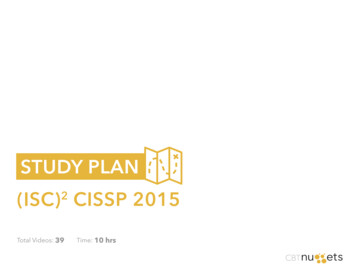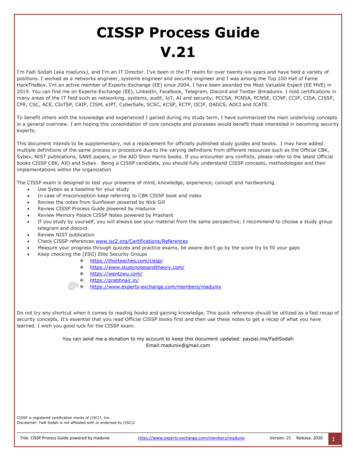
Transcription
CISSP Process GuideV.21I'm Fadi Sodah (aka madunix), and I'm an IT Director. I've been in the IT realm for over twenty-six years and have held a variety ofpositions. I worked as a networks engineer, systems engineer and security engineer and I was among the Top 100 Hall of FameHackTheBox. I'm an active member of Experts-Exchange (EE) since 2004. I have been awarded the Most Valuable Expert (EE MVE) in2019. You can find me on Experts-Exchange (EE), LinkedIn, Facebook, Telegram, Discord and Twitter @madunix. I hold certifications inmany areas of the IT field such as networking, systems, audit, IoT, AI and security: PCCSA, PCNSA, PCNSE, CCNP, CCIP, CISA, CISSP,CFR, CSC, ACE, CIoTSP, CAIP, CISM, eJPT, CyberSafe, SCSC, KCSP, KCTP, OCIF, OADCS, ADCI and ICATE.To benefit others with the knowledge and experienced I gained during my study term, I have summarized the main underlying conceptsin a general overview. I am hoping this consolidation of core concepts and processes would benefit those interested in becoming securityexperts.This document intends to be supplementary, not a replacement for officially published study guides and books. I may have addedmultiple definitions of the same process or procedure due to the varying definitions from different resources such as the Official CBK,Sybex, NIST publications, SANS papers, or the AIO Shon Harris books. If you encounter any conflicts, please refer to the latest Officialbooks CISSP CBK, AIO and Sybex. Being a CISSP candidate, you should fully understand CISSP concepts, methodologies and theirimplementations within the organization.The CISSP exam is designed to test your presence of mind, knowledge, experience, concept and hardworking. Use Sybex as a baseline for your study In case of misconception keep referring to CBK CISSP book and index Review the notes from Sunflower powered by Nick Gill Review CISSP Process Guide powered by madunix Review Memory Palace CISSP Notes powered by Prashant If you study by yourself, you will always see your material from the same perspective; I recommend to choose a study grouptelegram and discord. Review NIST publication Check CISSP references www.isc2.org/Certifications/References Measure your progress through quizzes and practice exams, be aware don’t go by the score try to fill your gaps Keep checking the (ESG) Elite Security Groups https://thorteaches.com/cissp/ https://www.studynotesandtheory.com/ https://wentzwu.com/ https://prabhnair.in/ https://www.experts-exchange.com/members/madunixDo not try any shortcut when it comes to reading books and gaining knowledge. This quick reference should be utilized as a fast recap ofsecurity concepts. It’s essential that you read Official CISSP books first and then use these notes to get a recap of what you havelearned. I wish you good luck for the CISSP exam.You can send me a donation to my account to keep this document updated: paypal.me/FadiSodahEmail:madunix@gmail.comCISSP is registered certification marks of (ISC)², Inc.Discalamer: Fadi Sodah is not affiliated with or endorsed by (ISC)2Title. CISSP Process Guide powered by dunixVersion. 21Release. 20201
Corporate Governance:Corporate governance is the set of responsibilities and practicesexercised by the board and executive management with the goal ofproviding strategic direction, ensuring that objectives are achieved,ascertaining that risk is managed appropriately and verifying thatthe enterprise's resources are used responsibly. Auditing supply chains Board and management structure and process Corporate responsibility and compliance Financial transparency and information disclosure Ownership structure and exercise of control rightsGovernance, Risk and Compliance (GRC):The process of how an organization manages its informationresources. This process usually includes all aspects of howdecisions are made for that organization, such as policies, rolesand procedures the organization uses to make those decisions. It isdesigned to ensure the business focuses on core activities, clarifieswho in the organization has the authority to make decisions,determines accountability for actions and responsibility foroutcomes, and addresses how expected performance will beevaluated.Areas of focus for IT Governance: Strategic alignment Value delivery Resource management Risk management Performance managementThe importance of following Infosec standards:Creating and using common, proven practices is an important partof a successful information security program. Not only dostandards support proactive management and efficient riskmitigation, adopting and consistently following a standard canbring additional benefits to any organization. TRUST & CONFIDENCE. When organizations obtain certificationsthat demonstrate compliance, they create a sense of trust andconfidence among employees and third parties with whom theyinteract. BETTER RESULTS. When you speak the same jargon, results aremore productive, effective, and cohesive. E.g., vendor assessmentscan be smoother and faster with a formal infosec program in place. COMPETITIVE ADVANTAGE. Developing a formal infosec programand obtaining certification boosts client and stakeholder confidencein how infosec risks are managed and aligned with their own riskappetite. CORPORATE RESPONSIBILITY. Holding an infosec certificationcan help organizations demonstrate due diligence and due care,which are mandatory requirements for company officers andessential for mitigating corporate negligence.Note: Information security standards offer best practices andshare expert information. These standards allow organizations toadopt, tailor, and implement a valuable infosec program withouthaving to hire full time experts, reinventing the wheel, and learningby trial and error, which is costly, time consuming and dangerous.Challenges of implementing and maintaining standards: Time: Implementing and maintaining information securityGovernance vs. Management:standards is not a one-time project. Rather, it is a process that Oversight vs. Implementationrequires dedicated, qualified personnel, support from senior Assigning authority vs. authorizing actionsleadership, and continuous monitoring and improvement. A Enacting policy vs. enforcingsuccessful effort will require buy-in from the entire organization. Accountability vs. responsibility Cost: Standards can be expensive to implement and just as Strategic planning vs. project planningcostly to maintain. In the case of ISO 27001, for example, in Resource allocation vs. resource utilizationNote: Governance: (What do we need to accomplish). Governance addition to the time and effort necessary to meet the standardtypically focuses on the alignment of internal requirements, such as requirements, organizations must budget for annual audit fees,corporate policies, business objectives, and strategy. Management: which can be substantial. Buy-in: Senior leadership buy-in and program ownership at the(How)C-level are critical elements for an organization to deploy anSecurity Policy:information security program effectively. The information security Define the scopeteam must share metrics, report the effectiveness of the program, Identify all assetsand demonstrate its value and strategic alignment with the Determine level of protectionorganization’s business objectives to maintain senior leadership Determine personal responsibilitysupport. Develop consequences for noncompliance Change management: In general, everyone appreciates the valueSecuring the Infrastructure:of securing information until it requires a change. Security teams Framework for Governanceimplementing standards are challenged to strike a delicate balance Risk Managementbetween security and convenience. The Security Program Continuous improvement: Standards have life cycles. When a Data Protectionstandard is updated, it is the responsibility of all compliant System and Data Managementorganizations to be aware of the updates and implement them by Security Awareness Trainingspecified dates, or as soon as possible if a time line is not User Provisioningmandated. In some cases, a standard might become obsolete, and Monitoring and Enforcementa new standard must be researched and presented to senior Incident Responseleadership for approval for implementation.Title. CISSP Process Guide powered by dunixVersion. 21Release. 20202
Access Control Review:The following is a review of the basic concepts in access control.Identification: Subjects supplying identification information Username, user ID, account numberAuthentication: Verifying the identification information Passphrase, PIN value, thumbprint, smart card, one-timepasswordAuthorization: Using the identity of the subject together with other criteria tomake a determination ofoperations that a subject can carry outon objects “I know who you are, now what am I going to allow you to do?”Accountability: Audit logs and monitoring to track subject activities with objectsAuthorization approval procedure: Formalized Approval by the direct manager, data owner, securityprofessional Access permissions follow the principle of least privilege Balance security with the need for access Avoid allowing too much privilege — Conflicts of interest Remove privilege when no longer neededDue Diligence vs. Due Care: Due Diligence: "Researching" -- Investigating and understandingrisks Due Diligence: “Doing” all the necessary tasks required tomaintain the due care Due Care: "Doing" -- Developing policies and procedures toaddress risk Due Care is to act responsiblyTitle. CISSP Process Guide powered by madunixData Protection:When you think about data protection, there are essentially 5 keytrends to be aware of: As always, the ability to recover data in the event of a lossor corruption is critical to why business does back up. It isa must. Next is disaster recovery (DR). In much the same way asapplication or data recovery, in the event of a naturaldisaster, the ability to get the business up and running isparamount. Statistically, businesses that can’t recoverfrom a disaster within 72 hours go out of business, sohaving a plan is critical, no matter the size of thebusiness. Business continuity is a superset of DR and having abusiness continuity plan would mean having a good DRplan. It is imperative that not only are applicationsprotected, but users can access the data and applicationsin the event of a disaster. The ability to reuse existing data for other businesspurposes. With the latest talk about “data being the newoil” or “natural useable resource,” companies that cantake advantage of this data are more likely to besuccessful. Having the ability to spin up copies of this dataquickly for other business uses such as DevOps, analytics,or reporting as well as supporting a good DR strategy hasbecome a way to take further advantage of your backupsolution. The latest entry to the list is cyber resiliency. While cyberresiliency has been important for a long time, it is now topof everyone’s mind due to the most recent attacks and thestatistics that talk about how cyber attacks costbusinesses a lot of money. The ability to recover from oneof these attacks is not as simple as just a data recovery,so new planning has to be part of how businesses protecttheir nixVersion. 21Release. 20203
Data at Rest:The term data at rest refers to data that lives in external orauxiliary storage devices,such as hard disk drives (HDDs), solid-state drives (SSDs), opticaldiscs (CD/DVD), or even on magnetic tape. A challenge to protectthe data in these states is, it is vulnerable, not only to threat actorsattempting to reach it over our systems and networks but also toanyone who can gain physical access to the device. Data protectionstrategies include secure access controls, the segregation of duties,and the implementation of the need to know mechanisms forsensitive data.Data in Use:Data in use refers to the information that is currently in use. It isused by staff, as in laptops or portable devices, and informationthat is being printed or copied to a USB stick. This is the dataavailable in endpoints. Data security controls for data in use wouldinclude port protection and whole disk encryption. Controls againstshoulder surfing, such as clear screen and clear desk policies, arealso applicable to data in user controls.Security:Security is a continuous process, not a one-shot project. Thesecurity life cycle or the security wheel is a continuous process thatconsists of several consequent phases (stages). The word cycleindicates the continuous and endless nature of such process. TheISO 27001 defines the cycle of the information securitymanagement system ISMS as PCDA: Plan-Do-Check-Act.Samples of testing CIA Triad: Security Functionality: Verify that the software behavesaccording to requirements, which should include security. Fuzz-testing (or fuzzing): Enter a wide variety of out-of-range Dynamic Validation: Use variable data in the code to ensure theintegrity of the software. Risk-Based Testing: Prioritize what features to test based on theirpotential risk and the impact of their failure. Penetration Testing: Play the role of an attacker, findingweaknesses and attempting exploits. Authentication Testing: Verify that communication over anetwork such as the Internet is protected by secure identificationmethods. Regression Testing Confirm that newer patches, updates, andfixes work with older code.Considerations for Security Controls include: Accountability (can be held responsible) Auditability (can it be tested?) A trusted source (source is known) Independence (self-determining) Consistently applied Cost-effective Reliable Independence from other security controls (no overlap) Ease of use Automation Sustainable Secure Protects confidentiality, integrity, and availability of assets Can be “backed out” in the event of an issue Creates no additional issues during operation Leaves no residual data from its functionBusiness Impact Assessment (BIA):A systematic process to determine and evaluate the potentialeffects of an interruption to critical business operations as a resultof exploitation, disaster, accident or emergency.Title. CISSP Process Guide powered by madunixBusiness Impact Assessment: Identify Priorities Identify Risk Likelihood Assessment Impact Assessment Resource prioritizationRisk can never be mitigated to zero (there is no such thing as “norisk” or “perfect security”)Business Impact Analysis: Identify critical functions Identify critical resources Calculate MTD for resources Identify threats Calculate risks Identify backup solutionsBusiness Impact Analysis: Select individuals to interview for data gathering Create data-gathering techniques Identify critical business functions Identify resources these functions depend upon Calculate how long these functions can survive without theseresources Identify vulnerabilities and threats Calculate the risk for each different business function Document findings and report them to managementKey Performance Indicator KPI based on: BIA Effort to implement Reliability SensitivitySecurity Programs Metrics: KPI looks backward at historical performance KRI looks forward, show how much risk exists that mayjeopardize the future security of the organization.Business Continuity Planning (BCP): Project Initiation Business Impact Analysis Recovery Strategy Plan design and development Implementation Testing Continual MaintenanceBCP (NIST 800-34): Develop a planning policy; BIA Identify preventive controls Create contingency strategies Develop contingency plans Test MaintenanceBusiness Continuity Planning (BCP): Provide immediate and appropriate response to emergencysituations Protect lives and ensure safety Reduce business impact Resume critical business functions Work with outside vendors and partners during the recoveryperiod Reduce confusion during a crisis Ensure survivability of the business Get "up and running" quickly after a adunixVersion. 21Release. 20204
DRP vs. BCP: BCP - Corrective Control DRP - Recovery Control Both BCP and DRP - fall under the category of CompensatingControl BCP – is not a preventive control as it can NOT prevent a disaster BCP - helps in the continuity of organization function in the eventof a disaster BCP - maintaining critical functions during a disruption of normaloperations DRP - recovering to normal operations after a disruptionBusiness Continuity Planning (BCP): Continuity Policy Business Impact Assessment (BIA) Identify Preventive Controls Develop Recovery Strategies Develop BCP Exercise/Drill/Test Maintain BCPDR Team: Rescue Team: Responsible for dealing with the immediacy of thedisaster –employee evacuation, crashing the server room, etc. Recovery Team: Responsible for getting the alternate facility upand running and restoring the most critical services first. Salvage Team: Responsible for the return of operations to theoriginal or permanent facility (reconstitution) – (get us back to thestage of normalcy)Business Continuity Planning (BCP) Documents: Continuity of planning goals Statement of importance and statement of priorities Statement of Organizational responsibilities Statement of Urgency and Timing Risk assessment, Risk Acceptance, and Risk mitigation document Vital Records Program Emergency Response Guidelines Documentation for maintaining and testing the planDRP/BCP document plan should be: Created for an enterprise with individual functional managersresponsible for plans specific to their departments Copies of the plan should be kept in multiple locations Both Electronic and paper copies should be kept The plan should be distributed to those with a need to know Most employers will only see a small portion of the planBusiness Continuity Planning (BCP): Project scope and planning Business Organization Analysis BCP team selection Resource Requirements Legal and regulatory requirements Business impact assessment Identify priorities Risk Identification Likelihood Assessment Impact Assessment Resource Prioritization Continuity planning Strategy Development Provisions and Processes Plan Approval Plan Implementation Training and Education Approval and implementation Approval by senior management (APPROVAL) Creating an awareness of the plan enterprise-wide(AWARENESS) Maintenance of the plan, including updating when needed(MAINTENANCE) ImplementationDevelopment of Disaster Recovery Plan (DRP): Plan Scope and Objectives Business Recovery Organization (BRO) and Responsibilities(Recovery Team) Major Plan Components - format and structure Scenario to Execute Plan Escalation, Notification and Plan Activation Vital Records and Off-Site Storage Program Personnel Control Program Data Loss Limitations Plan AdministrationDisaster Recovery Plan (DRP) procedures: Respond to disaster by a pre-defined disaster level Assess damage and estimate time required to resume operations Perform salvage and repairElements of Recovery Strategies: Business recovery strategy Focus on the recovery of business operations Facility & supply recovery strategy Focus on facility restoration and enable alternate recoverysite(s) User recovery strategy Focus on people and accommodations Technical recovery strategy Focus on the recovery of IT services Data recovery strategy Focus on the recovery of information assetsThe eight R’s of a successful Recovery Plan: Reason for planning Recognition Reaction Recovery Restoration Return to Normal Rest and Relax Re-evaluate and Re-documentTitle. CISSP Process Guide powered by dunixVersion. 21Release. 20205
Disaster Recovery Program: Critical Application Assessment Backup Procedures Recovery Procedures Implementation Procedures Test Procedures Plan MaintenanceRisk Analysis: Analyzing the environment for risks Creating a cost/benefit report for safeguards Evaluating threatPost-Incident Review:The purpose is how we get better; after a test or disaster hastaken place: Focus on how to improve What should have happened? What should happen next? Not who s fault it was; this is not productiveElements of risk: Threats Assets Mitigating factorsRisk Analysis methodology: CRAMM (CCTA Risk Analysis and Management Method) FMEA (Failure modes and effect analysis methodology) FRAP (Facilitated Risk Analysis Process) OCTAVE (Operationally Critical Threat, Asset, and VulnerabilityEvaluation)Continuity Planning: PUSHNormally applies to the mission/business itself; Concerns the ability Spanning Tree Analysisto continue critical functions and processes during and after an SOMAP (Security Officers Management and Analysis Project)emergency event. VAR (Value at risk)Contingency Planning:Applies to information systems, and provides the steps needed torecover the operation of all or part of the designated informationsystem at an existing or new location in an emergency.Business Continuity Plan (BCP):BCP focuses on sustaining an organization's mission/businessprocess during and after a disruption. It May be used for long-termrecovery in conjunction with the COOP plan, allowing for additionalfunctions to come online as resources or time allows.Occupant Emergency Plan (OEP):It outlines first-response procedures for occupants of a facility inthe event of a threat or incident to the health and safety of thepersonnel, the environment, or property.Cyber Incident Response Planning (CIRP):It’s A type of plan that normally focuses on detection, response,and recovery to a computer security incident or event. Itestablishes procedures to address cyber-attacks against anorganization's information system(s).Information System Contingency Plan (ISCP):It provides established procedures for the assessment andrecovery of a system following a system disruption. Provides keyinformation needed for system recovery, including roles andresponsibilities, inventory info, assessment procedures, detailedrecovery procedures, and testing of a system.RMF CSIAAM: (NIST 800-37):The risk management framework (RMF) encompasses a broadrange of activities to identify, control, and mitigate risks to aninformation system during the system development life cycle. Oneof the activities is the development of an ISCP. Implementing therisk management framework can prevent or reduce the likelihoodof the threats and limit the consequences of risks. RMF include: Categorize the information system and the data Select an initial set of baseline security controls Implement the security controls and describe how the controlsare employed Assess the security controls Authorize systems to be launched Monitor the security controlsRisk Management Process: (FARM): Framing risk Assessing risk Responding to risk Monitoring riskRisk management Policy Document: Objectives of the policy and rationale for managing risk Scope and charter of information risk management Links between the risk management policy and the organizationsstrategic and corporate business plans-Extent and range of issuesto which the policy appliesContinuity of Operations Plan (COOP): Guidance on what is considered acceptable risk levelsIt focuses on restoring an organization's mission essential function Risk management responsibilitiesof an alternate site and performing those functions for up to 30 Support expertise available to assist those responsible fordays before returning to normal operations.managing riskDisaster Recovery Plan (DRP): Degree of documentation required for various risk-managementApplies to major physical disruptions to service that deny access torelated activities, e.g., change managementthe primary facility infrastructure for an extended period. An A plan for reviewing compliance with the risk management policyinformation system-focused plan designed to restore operability of Incident and event severity levelsthe target system, application, or computer facility infrastructure at Risk reporting and escalation procedures, format and frequencyan alternate site after an emergency. Only addresses informationRisk Management Life Cycle:system disruptions that require relocation. Continuously monitoringRisks to the organization found in: Evaluating Financial Assessing and reporting risk. ReputationalRisk management: Regulatory Risk Assessment — Identify Assets, Threats Vulnerabilities Risk Analysis —Value of Potential Risk Risk Mitigation —Responding to Risk Risk Monitoring — Risk is foreverTitle. CISSP Process Guide powered by dunixVersion. 21Release. 20206
Risk management entails evaluating: Threats Vulnerabilities CountermeasuresMethodologies of Risk Assessment: Prepare for the assessment. Conduct the assessment: Identify threat sources and events. Identify vulnerabilities and predisposing conditions. Determine the likelihood of occurrence. Determine the magnitude of impact. Determine risk. Communicate results. Maintain assessment.Preparing Risk Assessment: Purpose of the assessment The scope of the assessment Assumptions and constraints associated with the assessment Sources of information to be used as inputs to the assessment Risk model and analytic approachesRisk Assessment (NIST 800-30): System / Asst. Characterization Threat Identification Vulnerability Identification Control Analysis Likelihood Determination Impact Analysis Risk Determination Control Recommendations Results DocumentationConfiguration Management: Plan Approve Baseline Implement Control Changes Monitor Report RepeatableConfiguration Configuration Configuration Configuration ConfigurationKey Challenges in Third-Party Risk Management: Increases the complexity of third-party network & it's managnt. Risk of failure to manage regulatory compliances Additional Cost for monitoring third-parties Lack of collaboration among parties Risk of information / data leakageKey Components of Third-Party Risk ManagementFramework:Following are the key components of Third-Party Risk Management(TPRM) Framework: Planning & process definition Segmentation & Screening Qualification Security & Permissions Workflows Risk Mitigation Continuous Monitoring Reports & Dashboard Centralized Repository Alert & NotificationDamage assessment: Determining the cause of the disaster is the first step of thedamage assessment How long it will take to bring critical functions back online Identifying the resources that must be replaced immediately Declare a disasterTitle. CISSP Process Guide powered by madunixDamage assessment: Determine the cause of the disaster. Determine the potential for further damage. Identify the affected business functions and areas. Identify the level of functionality for the critical resources. Identify the resources that must be replaced immediately. Estimate how long it will take to bring critical functions backonline. If it will take longer than the previously estimated MTD valuesto restore operations, then a disaster should be declared and BCPshould be put into action.Note: The first activity in every recovery plan is damage assessment,immediately followed by damage mitigation. The final step in a damage assessment is to declare a disaster. The decision to activate a disaster recovery plan is made afterdamage assessment and evaluation is completed.Management:IdentificationControlStatus AccountingAuditChange Control: Implement changes in a monitored and orderly manner. Changes are always controlled Formalized testing Reversed/rollback Users are informed of changes before they occur to prevent lossof productivity. The effects of changes are systematically analyzed. The negative impact of changes in capabilities, functionality,performance Changes are reviewed and approved by a CAB (change approvalboard).Change Management: Request for a change to take place Approval of the change Documentation of the change Tested and presented Implementation Report change to managementChange Management: Request Review Approve Schedule adunixVersion. 21Release. 20207
Change Management: Request Evaluate Test Rollback Approve Document Determine Change Window Implement Verify CloseEnterprise Security Architecture (ESA): Presents a long-term, strategic view of the system Unifies security controls Leverages existing technology investmentsImplement Fail-Safe Design:To implement fail-safe design, make sure that your software: Denies access by default in error-handling logic for securitycontrols. Failure should not result in elevated rights for an attacker. Put limits on recovery retry attempts. If your software continuallyattempts to do something that isn't working, it may overfill caches,bog the process down trying to retry overwhelming numbers ofbacked-up tasks, and so forth. Doesn't make assumptions about ways to remediate when failureoccurs. Fail bad inputs rather than attempting to correct themwhen you have no way to know what was intended. Suspend theaffected transaction and report it, so users and system operatorsare clear that the transaction did not go through.Patch Management: Patch Information Sources Prioritization Scheduling Testing Installation Assessment Audit Consistency CompliancePatch Management: Evaluate Test Approve Deploy VerifyPatch Management: Inventory Allocate Resources Pursue updates Test Change Approval Deployment plan Rollback plan Deploy and verify the updates with policy requirements DocumentProblem Management: Incident notification Root cause an
The CISSP exam is designed to test your presence of mind, knowledge, experience, concept and hardworking. Use Sybex as a baseline for your study In case of misconception keep referring to CBK CISSP book and index Review the notes from Sunflower powered by Nick Gill Review CISSP Process Guide powered by madunix
